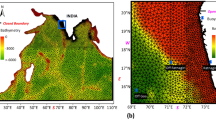Abstract
With all the improvement in wave and hydrodynamics numerical models, the question rises in our mind that how the accuracy of the forcing functions and their input can affect the results. In this paper, a commonly used numerical third-generation wave model, SWAN is applied to predict waves in Lake Michigan. Wind data are analyzed to determine wind variation frequency over Lake Michigan. Wave predictions uncertainty due to wind local effects are compared during a period where wind has a fairly constant speed and direction over the northern and southern basins. The study shows that despite model calibration in Lake Michigan area, the model deficiency arises from ignoring wind effects in small scales. Wave prediction also emphasizes that small scale turbulence in meteorological forces can increase prediction errors by 38%. Wave frequency and coherence analysis show that both models can predict the wave variation time scale with the same accuracy. Insufficient number of meteorological stations can result in neglecting local wind effects and discrepancies in current predictions. The uncertainty of wave numerical models due to input uncertainties and model principals should be taken into account for design risk factors.
Similar content being viewed by others
References
Battjes, J. A., 2006. Developments in coastal engineering research, Coast. Eng., 53(2–3): 121–132.
Beletsky, D., Schwab, D. and McCormick, M., 2006. Modeling the 1998–2003 summer circulation and thermal structure in Lake Michigan, Journal of Geophysical Research: Oceans, 111(C10): C10010.
Blumberg, A. F. and Georgas, N., 2008. Quantifying uncertainty in estuarine and coastal ocean circulation modeling, J. Hydraul. Eng., ASCE, 134(4): 403–415.
Booij, N., Ris, R. C. and Holthuijsen, L. H., 1999. A third-generation wave model for coastal regions 1. Model description and validation, Journal of Geophysical Research: Oceans, 104(C4): 7649–7666.
Dragani, W. C. and Romero, S. I., 2004. Impact of a possible local wind change on the wave climate in the upper Rio De La Plata, Int. J. Climatol., 24(9): 1149–1157.
Ghil, M., Allen, M. R., Dettinger, M. D., Ide, K., Kondrashov, D., Mann, M. E., Robertson, A. W., Saunders, A., Tian, Y., Varadi, F. and Yiou, P., 2002. Advanced spectral methods for climatic time series, Rev. Geophys., 40(1): 1–41.
Hamidi, S. A., Bravo, H. R., Klump, J. V. and Waples, J. T., 2015. The role of circulation and heat fluxes in the formation of stratification leading to hypoxia in Green Bay, Lake Michigan, Journal of Great Lakes Research, 41(4): 1024–1036.
Hamidi, S. A., Bravo, H. R. and Klump, J. V., 2013. Evidence of multiple physical drivers on the circulation and thermal regime in the Green Bay of Lake Michigan, in: World Environmental and Water Resources Congress, ASCE, 1719–1726.
Jalili, S., Hamidi, S. A. and Ghanbari, R. N., 2015. Climate variability and anthropogenic effects on Lake Urmia water level fluctuations, Northwestern Iran, Hydrolog. Sci. J., doi:10.1080/02626667.2015.1036757.
Jönsson, A., Danielsson, A. and Rahm, L., 2005. Bottom type distribution based on wave friction velocity in the Baltic Sea, Cont. Shelf Res., 25(3): 419–435.
Lin, P. Z. and Li, C. W., 2002. A σ-coordinate three-dimensional numerical model for surface wave propagation, Int. J. Numer. Meth. Fl., 38(11): 1045–1068.
Liu, P. C., 2000. Wave grouping characteristics in nearshore Great Lakes, Ocean Eng., 27(11): 1221–1230.
Liu, P. C., Schwab, D. J. and Bennett, J. R., 1984. Comparison of a two-dimensional wave prediction model with synoptic measurements in Lake Michigan, J. Phys. Oceanogr., 14(19): 1514–1518.
Moeini, M. H. and Etemad-Shahidi, A., 2007. Application of two numerical models for wave hindcasting in Lake Erie, Appl. Ocean Res., 29(3): 137–145.
Monbaliu, J., Padilla-Hernández, R., Hargreaves, J. C., Carretero Albiach, J. C., Luo, W. M., Sclavo, M. and Günther, H., 1999. The spectral wave model, WAM, adapted for applications with high spatial resolution, Coast. Eng., 41(1): 41–62.
Nielsen, M., 1999. A method for spatial interpolation of wind climatologies, Wind Energy, 2(3): 151–166.
Rao, D. B., Mortimer, C. H. and Schwab, D. J., 1976. Surface normal modes of Lake Michigan: Calculations compared with spectra of observed water level fluctuations, J. Phys. Oceanogr., 6(4): 575–588.
Resio, D. T. and Perrie, W., 1989. Implications of an f−4 equilibrium range for wind-generated waves, J. Phys. Oceanogr., 19(2): 193–204.
Saylor, J. H., Miller, G. S. and Gottlieb, E. S., 1995. Near-Resonant Wind Forcing of Internal Seiches in Green Bay, Lake Michigan, NOAA GLERL Contribution Number 790.
Schwab, D. J. and Morton, J. A., 1984. Estimation of overlake wind speed from overland wind speed: A comparison of three methods, Journal of Great Lake Research, 10(1): 68–72.
Schwab, D. J., 1978. Simulation and forecasting of Lake Erie storm surges, Mon. Weather Rev., 106, 1476–1487.
Sebastião, P., Guedes Soares, C. and Booji, N., 2000. Wave hindcasting off the coast of Portugal, Coast. Eng., 40(4): 411–425.
Soomere, T. and Keevallik, S., 2003. Directional and extreme wind properties in Gulf of Finland, Proceedings of the Estonian Academy of Sciences, Engineering, 9(2): 73–90.
The WAMDI Group, 1988. The WAM model–A third generation ocean wave prediction model, J. Phys. Oceanogr., 18(12): 1775–1810.
Thomson, D. J., 1982. Spectrum estimation and harmonic analysis, Proc. IEEE, 70(9): 1055–1096.
Vikebø, F., Furevik, T., Furnes, G., Kvamstø, N. G. and Reistad, M., 2002. Wave height variations in the North Sea and on the Norwegian Continental Shelf, 1881–1999, Cont. Shelf Res., 23(3–4): 251–263.
Author information
Authors and Affiliations
Corresponding author
Rights and permissions
About this article
Cite this article
Nekouee, N., Ataie-Ashtiani, B. & Hamidi, S.A. Uncertainty analysis of wind-wave predictions in Lake Michigan. China Ocean Eng 30, 811–820 (2016). https://doi.org/10.1007/s13344-016-0052-4
Received:
Revised:
Accepted:
Published:
Issue Date:
DOI: https://doi.org/10.1007/s13344-016-0052-4




